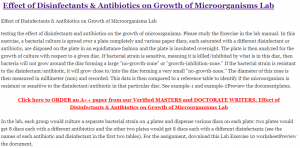Effect of Disinfectants & Antibiotics on Growth of Microorganisms Lab
Effect of Disinfectants & Antibiotics on Growth of Microorganisms Lab
testing the effect of disinfectants and antibiotics on the growth of microorganisms. Please study the Exercise in the lab manual. In this exercise, a bacterial culture is spread over a plate completely and various paper discs, each saturated with a different disinfectant or antibiotic, are disposed on the plate in an equidistance fashion and the plate is incubated overnight. The plate is then analyzed for the growth of culture with respect to a given disc. If bacterial strain is sensitive, meaning it is killed/inhibited by what is in this disc, then bacteria will not grow around the disc forming a large “no-growth-zone” or “growth-inhibition-zone.” If the bacterial strain is resistant to the disinfectant/antibiotic, it will grow close to/into the disc forming a very small “no-growth-zone.” The diameter of this zone is then measured in millimeter (mm) and recorded. This data is then compared to a reference table to identify if the microorganism is resistant or sensitive to the disinfectant/antibiotic in that particular disc. See example-1 and example-2Preview the documentplates.

Effect of Disinfectants & Antibiotics on Growth of Microorganisms Lab
In the lab, each group would culture a separate bacterial strain on 4 plates and dispense various discs on each plate: two plates would get 8 discs each with a different antibiotics and the other two plates would get 8 discs each with a different disinfectants (see the names of each antibiotic and disinfectant in the first two tables). For the assignment, download this Lab Exercise 10 worksheetPreview the document,
Disinfectants are widely used to get rid of microorganisms whether in hospitals, health centers or for normal domestic use. Some suggested that when disinfectants are incorrectly diluted the disinfectant might promote the growth of antibiotic-resistant bacteria, therefore, in this study pathogenic bacterium ( Pseudomonas aeruginosa ), isolated from patient with urinary tract infection, treated with two locally popular disinfectants (Claradone and Sarttol). Results showed that the bacterial growth was affected by both disinfectants. The lowest concentration of Claradone that inhibit the growth of this bacterium is considered as the minimum inhibitory concentration (MIC), this was 30%, while the lowest effecting concentration of Sarttol was 3%. A number of survival colonies after treated with high concentration of Calarodone and Sarttol were investigated for their susceptibility to antibiotics, using standard disc diffusion method. Results indicated that these colonies of P. aeruginosa resisted antibiotics they were sensitive to before treatment. So it can be concluded that using Claradone and sarttol can make the pathogenic bacterium ( P. aeruginosa ) resist some antibiotics.
Do you need a similar assignment written for you from scratch? We have qualified writers to help you.
You can rest assured of an A+ quality paper that is plagiarism free. Order now for a FREE first Assignment!
Use Discount Code "FREE" for a 100% Discount!
NB: We do not resell papers. Upon ordering, we write an original paper exclusively for you.

